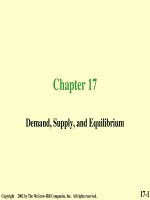Lecture Economics (6/e): Chapter 13 - Stephen L. Slavin
Bạn đang xem bản rút gọn của tài liệu. Xem và tải ngay bản đầy đủ của tài liệu tại đây (438.88 KB, 58 trang )
Chapter 13
Money and Banking
Copyright 2002 by The McGrawHill Companies, Inc. All rights reserved.
131
Chapter Objectives
•
•
•
•
The four jobs of money
What money is
M1, M2, and M3
The demand for money
Copyright 2002 by The McGrawHill Companies, Inc. All rights reserved.
132
Chapter Objectives
•
•
•
•
•
The origins of banking
The creation and destruction of money
Branch banking and bank chartering
The FDIC
The savings and loan debacle
Copyright 2002 by The McGrawHill Companies, Inc. All rights reserved.
133
The Four Jobs of Money
• Medium of exchange
• Standard of value
• Store of value
• Standard of deferred
payment
Copyright 2002 by The McGrawHill Companies, Inc. All rights reserved.
134
Medium of Exchange
• The most important job of money is to serve as
a medium of exchange
– When any good or service is purchased, people use
money
– Money makes it easier to buy and sell because
money is universally accepted
– Money, then, provides us with a shortcut in doing
business
• By acting as a medium of exchange, money
performs its most important function
Copyright 2002 by The McGrawHill Companies, Inc. All rights reserved.
135
Standard of Value
• Money is a common denominator in
which the relative value of goods and
services can be expressed
– A job that pays $2 an hour would be nearly
impossible to fill, while one paying $50 an
hour would be swamped with applications
– Does money work well as a standard of
value? You tell me
Copyright 2002 by The McGrawHill Companies, Inc. All rights reserved.
136
Store of Value
• If you could buy 100 units of goods and services
with $100 in 1982, how many units could you
buy with $100 in 2000?
– Answer: you could have bought just 51 units
– During this period, inflation robbed the dollar of
almost half of its purchasing power
• Over the long run, particularly since World
War II, money has been a very poor store of
value
– However, over relatively short periods of time, say,
a few weeks or months, money does not lose much of
its value
137
Copyright 2002 by The McGrawHill Companies, Inc. All rights reserved.
Standard of Deferred Payment
• Many contracts promise to pay fixed
sums of money well into the future
– A couple of examples are 30year corporate
bonds and a 20year mortgage
Copyright 2002 by The McGrawHill Companies, Inc. All rights reserved.
138
Standard of Deferred Payment
• When Dave Winfield signed a 10year,
$23 million contract with the New York
Yankees in 1980, he really got stuck
– Because over the next 10 years the consumer
price index went up by almost 59%
– Today when a professional ballplayer,
entertainer, or virtually anyone else signs a
longterm contract, she or he is generally
protected by an escalator clause, which calls
for increased payments to compensate for
any future inflation
Copyright 2002 by The McGrawHill Companies, Inc. All rights reserved.
139
Standard of Deferred Payment
• How well does money do its job as a
standard of deferred payment?
– About as well as it does as a store of value
– Usually quite well in the short run, but not
well at all over the long run of, say, three
years or more
Copyright 2002 by The McGrawHill Companies, Inc. All rights reserved.
1310
Money versus Barter
• Without money, the only way to do business is
by bartering
• For barter to work, I must want what you have
and you must want what I have
– This makes it pretty difficult to do business
• “Everything, then, must be assessed in money:
for this enables men always to exchange their
services, and so makes society possible”
– Aristotle, Nicomachean Ethics
Copyright 2002 by The McGrawHill Companies, Inc. All rights reserved.
1311
Our Money Supply
• Money consist of coins, paper money, demand
(or checking) deposits, and checklike deposits
(commonly called NOW – or negotiable order
of withdrawal – accounts) held by the nonbank
public
– Coins and paper money together are considered
currency
– Six of every ten dollars in our money supply are
demand deposits and other checkable deposits
• Virtually all the rest is currency
– Checks are not money but checking deposits are
Copyright 2002 by The McGrawHill Companies, Inc. All rights reserved.
1312
Our Money Supply
Federal Reserve Statistical Release, April 5, 2001
Copyright 2002 by The McGrawHill Companies, Inc. All rights reserved.
1313
Our Money Supply: M1, M2, M3
Currency
+ Demand deposits
+ Other checkable deposits
+ Traveler’s checks
M1(traditionally our basic money supply)
Copyright 2002 by The McGrawHill Companies, Inc. All rights reserved.
1314
Our Money Supply: M1, M2, M3
Currency
+ Demand deposits
+ Other checkable deposits
+ Traveler’s checks
M1
+ Savings deposits
+ Smalldenomination time deposits (less than $100,00)
+ Money market mutual funds held by individuals
M2
Copyright 2002 by The McGrawHill Companies, Inc. All rights reserved.
1315
Our Money Supply: M1, M2, M3
Currency
+ Demand deposits
+ Other checkable deposits
+ Traveler’s checks
M1
+ Savings deposits
+ Smalldenomination time deposits (less than $100,00)
+ Money market mutual funds held by individuals
M2
+ Large denomination time deposits (more than $100,00)
+ Money market mutual funds held by institutions
+ Other less liquid assets
M3
Copyright 2002 by The McGrawHill Companies, Inc. All rights reserved.
1316
Our Money Supply
M1, M2, and M3, January 2001
Federal Reserve Bulletin
M1=1,107
Currency in
circulation
539
Traveler's
checks
8
Other
checkable
deposits
251
Demand
deposits
309
M2=5,111
M1
1107
Money market
mutual funds
held by individuals
985
M3=7,361
Money market mutual funds
held by institutions
903
Saving
deposits
1970
Large-denomination
time deposits
797
Other less
liquid assets
550
Small-denomination
time deposits
1049
Copyright 2002 by The McGrawHill Companies, Inc. All rights reserved.
M2
5111
1317
Our Growing Money Supply
Annual Percentage Change in the Money Supply, M1, 19602000
20
18
16
14
12
10
8
6
4
2
0
Ð2
Ð4
1960
1964
1968
1972
1976
1980
1984
1988
Copyright 2002 by The McGrawHill Companies, Inc. All rights reserved.
1992
1996
2000
1318
The Demand for Money
• The amount of money people hold is called
money balances
• John Maynard Keynes noted that people had
three reasons for holding money
– People hold money to make transactions
– People hold money for precautionary reasons
– People hold money to speculate
• Economists have since identified four factors
that influence the three Keynesian motives for
holding money
–
–
–
–
The price level
Income
The interest rate
Credit availability
Copyright 2002 by The McGrawHill Companies, Inc. All rights reserved.
1319
The Keynesian Motives for
Holding Money
• The transaction motive
– Individuals have daytoday purchases for
which they pay in cash or by check
– Individuals take care of their rent or
mortgage payment, car payment, monthly
bills and major purchases by check
– Businesses need substantial checking
accounts to pay their bills and meet their
payrolls
Copyright 2002 by The McGrawHill Companies, Inc. All rights reserved.
1320
The Keynesian Motives for
Holding Money
• The precautionary motive
– People will keep money on hand just in case
some unforeseen emergency arises
• They do not actually expect to spend this money,
but they want to be ready if the need arises
Copyright 2002 by The McGrawHill Companies, Inc. All rights reserved.
1321
The Keynesian Motives for
Holding Money
• The speculative motive
– When interest rates are very low you don’t
stand to lose much holding your assets in the
form of money
– Alternatively, by tying up your assets in the
form of bonds, you actually stand to lose
money should interest rates rise
• You would be locked into very low rates
– This motive is based on the belief that better
opportunities for investment will come along
and that, in particular, interest rates will rise
Copyright 2002 by The McGrawHill Companies, Inc. All rights reserved.
1322
Four Influences on the Demand
for Money
• The price level
– As the price level rises, people need to hold higher
money balances to carry out daytoday transactions
– As the price level rises, the purchasing power of the
dollar declines, so the longer you hold money, the
less that money is worth
– Even though people tend to cut down on their
money balances during periods of inflation, as the
price level rises people will hold larger money
balances
Copyright 2002 by The McGrawHill Companies, Inc. All rights reserved.
1323
Four Influences on the Demand
for Money
• Income
– The more you make, the more you spend
– The more you spend, the more money you
need to hold as cash or in your checking
account
– Therefore as income rises, so does the
demand for money balances
Copyright 2002 by The McGrawHill Companies, Inc. All rights reserved.
1324
Four Influences on the Demand
for Money
• Interest rates
– The quantity of money demanded (held) goes
down as interest rates rise
• The alternative to holding your assets in the form
of money is to hold them in some type of interest
bearing paper
• As interest rates rise, these assets become more
attractive than money balances
Copyright 2002 by The McGrawHill Companies, Inc. All rights reserved.
1325









